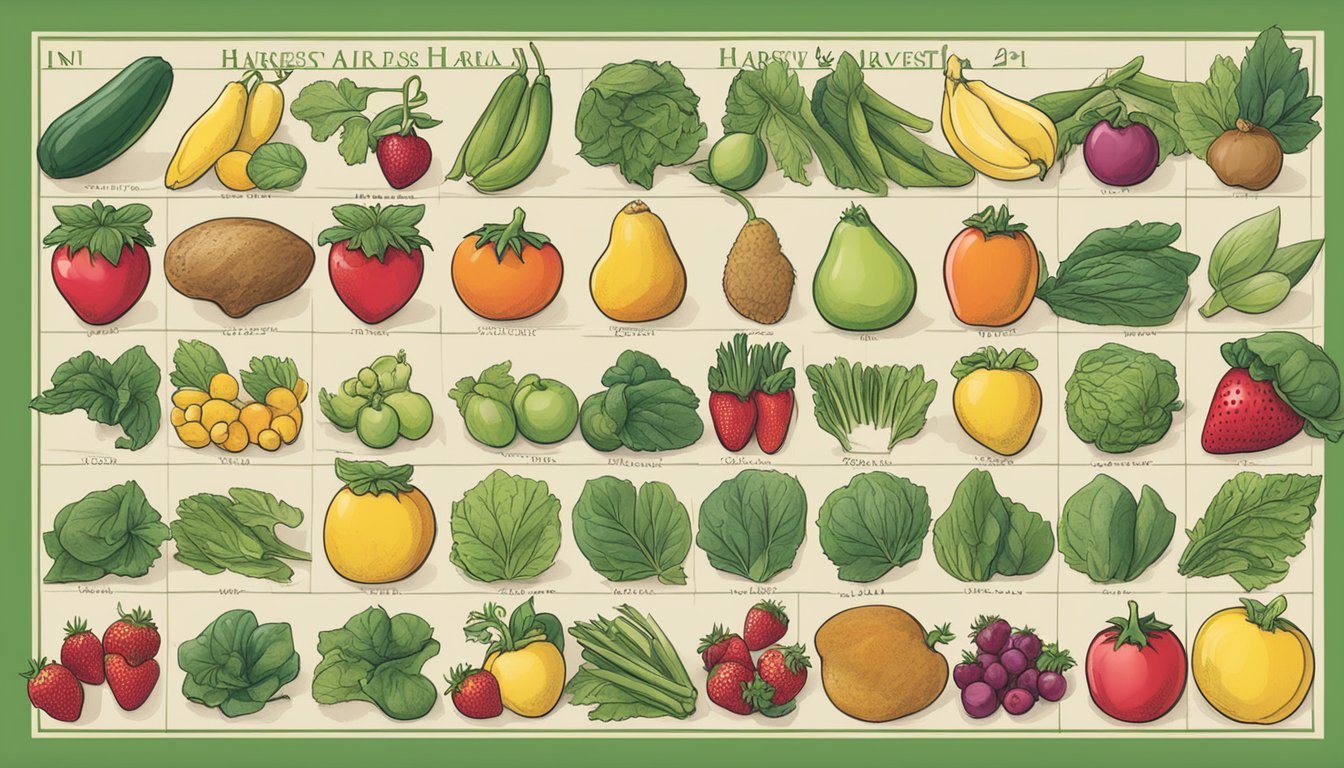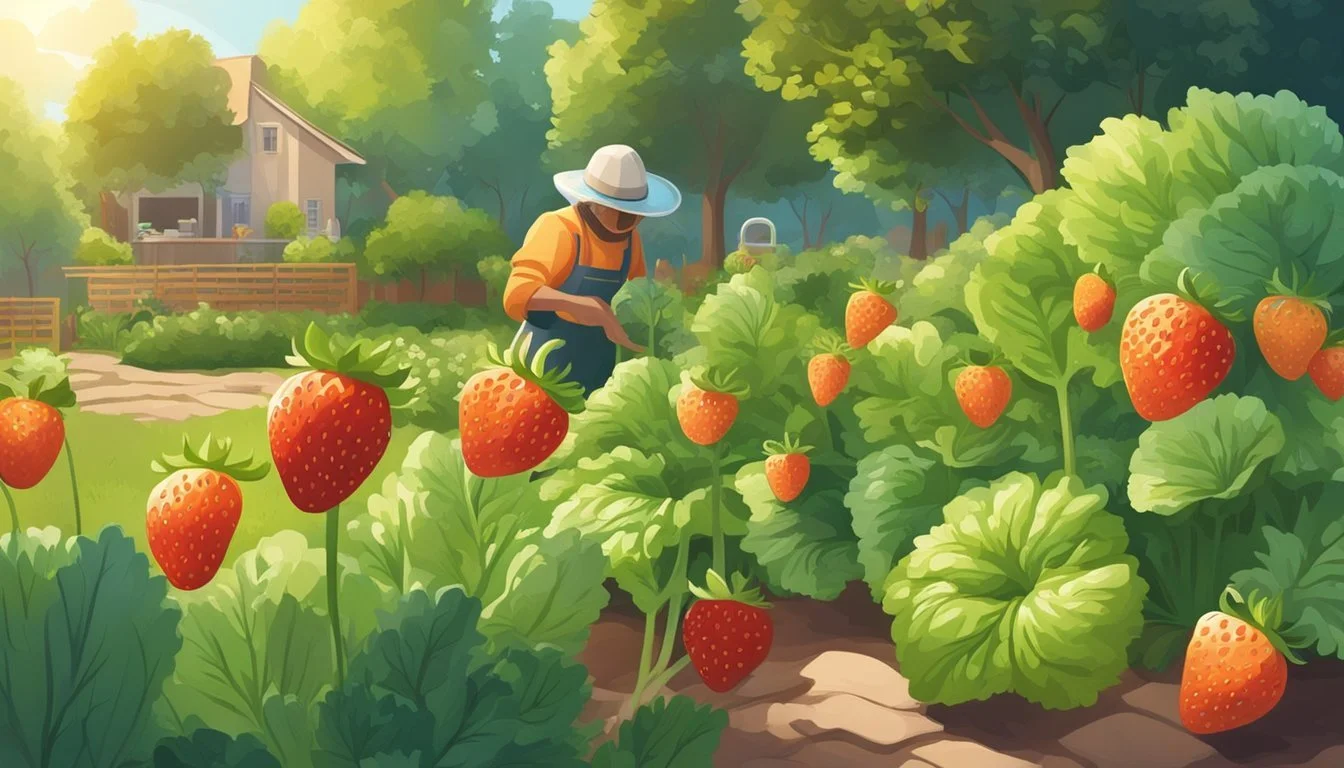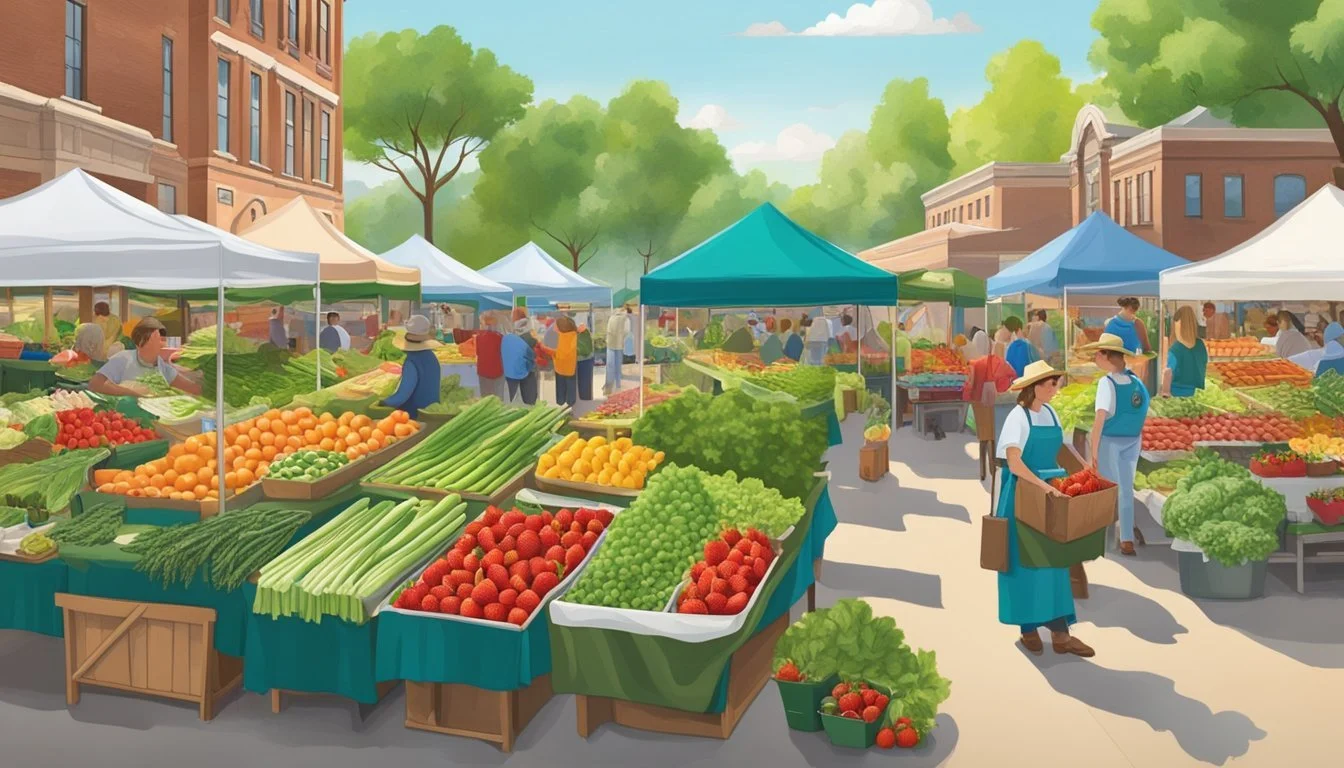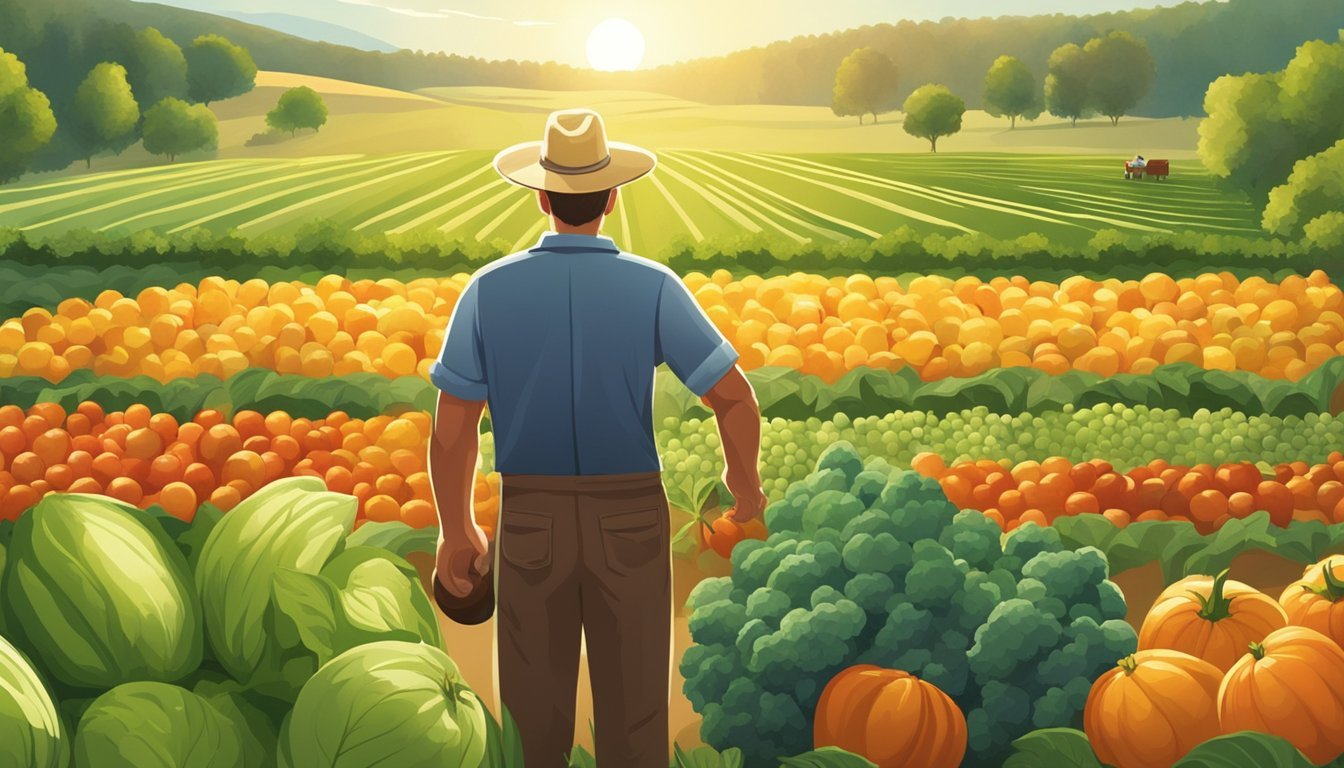South Dakota Seasonal Fruit & Vegetables in April
A Guide to Fresh Produce Selection
This Article is Part of our South Dakota Seasonal Fruit & Veg Calendar
April in South Dakota marks a transitional period in agriculture, as the state emerges from the harsh Midwestern winter into the promising thaw of spring. This month does not typically abound with a wide variety of fresh produce due to the region's climate, but it does begin to offer certain cold-hardy vegetables. Root vegetables and select greens often endure the cool April climate, providing residents with nutritious options before the full advent of summer's bounty.
South Dakota's growers make use of the early spring to provide a selection of produce that can tolerate frost and colder soil temperatures. Hardy vegetables like kale and spinach (What wine goes well with spinach?) continue to be available, having the resilience to thrive in cooler weather. While the diversity of fruits is not as prolific in April, the focus on vegetables meets both nutritional needs and the regional capacity for growth during this season.
Understanding South Dakota's Growing Seasons
South Dakota's growing seasons are significantly influenced by its varied hardiness zones and the April spring planting schedule. Farmers and gardeners must navigate these factors to optimize their crop yields.
Spring Planting in April
April in South Dakota marks the onset of the spring planting season, but with caution against lingering frost. Farmers typically prepare the soil for crops known to withstand cooler conditions, such as:
Salad greens
Radishes
Peas
Frost-tolerant vegetables are ideal during this time, as in-season crops must endure the unpredictability of a South Dakota spring. The actual planting dates vary by year and location, but mid to late April is a common starting point for these cool-season crops.
Hardiness Zones in South Dakota
South Dakota encompasses several USDA plant hardiness zones, which are:
Zone 3: Characterized by an extremely short growing season and very cold winter temperatures.
Zone 4: Has a shorter growing season and is subject to cold temperatures in winter.
Zone 5: Offers a longer growing season and milder winters compared to zones 3 and 4.
Understanding the distinct zones is crucial for selecting appropriate crops and planting times. Each zone delineates where certain fruits and vegetables are more likely to thrive during the summer, fall, and even winter months. Gardeners and farmers in South Dakota must select plant varieties that are suitable to their local zones for best results.
April's Harvest Calendar for South Dakota
April brings a transition period for South Dakota’s agriculture where early spring offerings begin to make their appearance.
Vegetables Available in April
In April, gardeners and farmers in South Dakota can expect to see a variety of cool weather vegetables thriving despite the temperamental early spring temperatures. The robust root vegetables from winter stores are still in circulation, particularly:
Potatoes
Onions
Additionally, some early-sprouting vegetables are typically ready to harvest, such as:
Radishes
Spinach
Fruits to Expect in April
Fruit harvests in South Dakota are sparse in April, as many fruit crops are just beginning to bloom during this time. However, some fruits may be available from storage, including:
Apples (from storage)
Herbs and Greens
Herbs and leafy greens are some of the first plants to flourish in the cool beginnings of the South Dakota spring. Individuals looking to enhance their meals with fresh greens and herbs can look forward to:
Chives (how long do chives last?)
Parsley
These herbs are hardy and capable of growing in the cool temperatures that April often presents. The greens, already listed under vegetables such as spinach, are also a fresh supplement for spring diets.
Seasonal Selections: Vegetables
In April, South Dakota's selection of vegetables includes a variety of root vegetables nearing their peak, emerging leafy greens, and the first of the cruciferous and marrow vegetables, ensuring freshness and local availability.
Root Vegetables in Season
Within South Dakota, root vegetables such as carrots (how long do carrots last?), radishes, and onions are harvested with their fullest flavors in April. These vegetables continue to be staple choices for their storage capability and wholesome taste, with many still available from local producers who store them through winter to extend their season.
Potatoes: Cooler storages keep potatoes fresh.
Onions: Remaining from winter stocks, they are versatile in the kitchen.
Carrots: Sweet and crunchy, ideal for both raw and cooked dishes.
Radishes: Offer a peppery bite, perfect for adding a fresh crunch to salads.
Leafy Greens and Salads
April marks the entrance of tender lettuce and various salad greens, which start to thrive in the gradually warming temperatures. Kale, in particular, can withstand the cooler nights while providing nutrient-rich leaves for a variety of dishes.
Lettuce: Crisp and fresh for spring salads.
Salad Greens: A range of greens emerge, offering variety in flavor and texture.
Kale: Hardy, with a slight sweetness from the lingering cool weather.
Cruciferous and Marrow Vegetables
Towards the end of April, early plantings of broccoli and cauliflower (how long does cauliflower last?) may begin to appear. These veggies prefer cooler growing conditions and can be found fresh in South Dakota, brought directly from farm to table in the spring season.
Broccoli: Rich in vitamins and best when freshly harvested.
Cauliflower: Versatile and flavorful, especially when eaten fresh.
Seasonal Picks: Fruits
April’s fresh selection in South Dakota is not abundant, as it is early in the season for most fruit harvests. However, one bright and tangy exception thrives early in the year — rhubarb. This hearty perennial is often one of the first plants to poke through the soil as early as April.
Though technically classified as a vegetable, rhubarb is commonly paired with sweet fruits in culinary uses, such as in pies and desserts. The plant's stalks are the only edible part, as the leaves contain oxalic acid and should not be consumed.
Here is what consumers can expect from rhubarb in April:
Availability: Rhubarb begins its season, and consumers can find the tart stalks ready for purchase.
Preparation: It's typically used in sweet settings but works well with savory dishes too. The stalks can be stewed, baked, or used in sauces.
Nutrition: Rich in vitamins K and C, it also offers dietary fiber and calcium.
It's important for buyers to seek out firm, crisp stalks with a vivid red color, signifying freshness and flavor. Rhubarb's peak seasons extend beyond April, but enthusiasts may start to see these tart stalks appearing in local markets or farms early in the month.
Do note that other fruits traditionally associated with the spring and summer months, like strawberries, are not yet in season. Patrons looking to pair rhubarb with strawberries for classic dessert dishes like strawberry-rhubarb pie might consider using preserved or frozen strawberries until the fresh fruit becomes available later in the season.
Gardening Tips for April
In South Dakota, April ushers in a time for gardeners to actively prepare and maintain gardens for the growing season. Optimal soil preparation and awareness of frost are crucial for success.
Starting Your Garden
Gardeners in South Dakota should consider planting hearty vegetables that can withstand the unpredictable April weather. Vegetables such as broccoli, cabbage, Brussels sprouts, carrots, beets, lettuce, cauliflower, potatoes, and peas are suitable for an early start. One should wait for the soil to warm to over 60° Fahrenheit before planting beans and corn.
Frost Considerations
The state can experience late frosts in April. It's vital to monitor the local frost dates and prepare to protect tender plants. Options include using frost cloths or planting in sheltered areas. It's also recommended to plant frost-tolerant species to reduce risk.
Soil Preparation and Maintenance
Proper soil preparation is key:
Testing: Begin with a soil test to determine pH and nutrient levels.
Amending: Based on test results, amend the soil with compost or the necessary fertilizers.
Tilling: Till the soil to a depth of 8-12 inches to incorporate organic matter and improve drainage.
For maintenance, regular weeding and watering will ensure that the soil remains conducive for plant growth.
Farmers' Markets and Local Produce
In April, South Dakota's farmers' markets become vibrant hubs for purchasing fresh, local produce. Consumers can enjoy the freshness and support regional agriculture at several market locations.
Finding Fresh Produce in South Dakota
South Dakota's farmers' markets, such as those in Sioux Falls, Rapid City, Aberdeen, Brookings, and Watertown, offer an array of fresh produce during April. These markets typically source fruits and vegetables from local farms, ensuring shoppers get the most flavorful and nutrient-rich options. Availability largely depends on the season, but early offerings might include spring greens, radishes, and herbs.
Major Farmers' Markets in South Dakota:
Sioux Falls: The Sioux Falls Farmers' Market provides a variety of seasonal produce from local vendors.
Rapid City: At the Rapid City Farmers' Market, shoppers find regional specialties and early-season crops.
Aberdeen: Aberdeen's farmers' market is a go-to spot for residents seeking out locally-produced goods.
Brookings: Brookings offers community access to fresh foods directly from the producers.
Watertown: The Watertown market stands as a venue for fresh, quality local produce.
Supporting Local Farmers
By purchasing directly from farmers' markets, individuals contribute to the livelihoods of local farmers and the economy of South Dakota. This system of support aids in sustaining farming operations and preserving the agricultural landscape of the United States. Consumers also encourage the circulation of resources within their community, reinforcing local business and fostering regional self-reliance.
Eating Seasonally for Optimal Flavor and Nutrition
Eating seasonally ensures that individuals enjoy fruits and vegetables at their peak flavor and nutritional value. In South Dakota, April is a transitional month where the last of winter's produce gives way to the first fresh offerings of spring.
Seasonal vegetables and fruits harvested in April have spent the appropriate amount of time ripening naturally on the vine or in the ground. This maturation process contributes to a richer flavor profile and higher concentrations of essential nutrients.
Vegetables: Early spring in South Dakota brings a variety of leafy greens, which are both flavorful and nutritionally dense. They retain more vitamins and minerals as they do not have to endure long transport times which can degrade these qualities.
Spinach
Radishes
Lettuce
Fruits: While fruit variety is less extensive in April compared to summer months, selections like rhubarb start to make their appearance. Rhubarb, commonly used in pies, is actually a vegetable, but is often included with fruits in culinary practices due to its tart flavor suited for desserts.
Availability of produce is more predictable when sourced locally and seasonally. Farmers' markets and local supermarkets frequently stock up on these seasonal items, making them readily accessible to consumers.
Month Available Produce April Spinach, Radishes, Lettuce, Rhubarb
Consumers are encouraged to take advantage of these seasonal offerings for meals rich in flavor and nutritional benefits. Freshness is virtually guaranteed when produce is consumed close to its harvest date, and South Dakota's April selections are no exception.
Seasonal Recipes Featuring April Produce
April brings a bounty of fresh vegetables and fruits to South Dakota. Utilizing these local and seasonal ingredients not only supports the local economy but also ensures that the food on your table is at peak freshness. The following recipes leverage the best that April has to offer in South Dakota.
Asparagus (What wine goes well with asparagus?) takes center stage with its tender and earthy stalks. Try a simple roasted asparagus with a drizzle of olive oil, sea salt (how long does sea salt last?), and a squeeze of lemon to elevate the natural flavors.
Radishes, with their crisp texture and slightly peppery taste, are perfect for adding a fresh crunch to salads. Slice them thinly and mix into a spring greens salad for a pop of color and bite.
Carrots are sweet and versatile, coming into their own in April. They make for a vibrant carrot soup, which can be accented with a hint of ginger for warmth or a touch of cream for richness.
Strawberries begin to make an appearance and are superb in desserts or as a sweet-tart component in salads. A classic strawberry spinach salad with a balsamic dressing is refreshing and epitomizes the essence of spring recipes.
Here is a quick table showcasing a recipe for each of these seasonal stars:
Ingredient Recipe Idea Description Asparagus Roasted Asparagus Tossed with olive oil, seasoned, and baked until tender-crisp. Radishes Spring Greens Salad Sliced radishes adding crunch to a bed of mixed spring greens. Carrots Creamy Carrot Soup Pureed carrots with a hint of spices, enriched with cream. Strawberries Strawberry Spinach Salad Fresh strawberries mixed with spinach, nuts, and vinaigrette.
Chefs and home cooks alike can make the most of April’s produce by incorporating these suggestions into their cooking routine for meals that are not only seasonally appropriate but also teem with the freshness that only comes from eating what’s naturally ripened and ready to be enjoyed.
Planning Ahead: Preparing for South Dakota's Summer Harvest
As April unfolds in South Dakota, it marks a critical time for gardeners and farmers to prepare for the upcoming summer harvest. Attention to planting schedules and maintenance plans is key for a bountiful season of summer fruits and vegetables.
Anticipating Summer Fruits and Vegetables
South Dakota's summer harvest promises a variety of fruits and vegetables. July is the peak month when the bulk of the crops like tomato, peppers, corn, cucumbers, and summer squash ripen. Gardeners should anticipate the specific harvest times for these staples to ensure a successful season.
Tomatoes and Peppers: Typically ready to begin harvesting in early to mid-summer.
Corn: Looks for its high season in July when the stalks reach their full height and the kernels are plump.
Cucumbers and Summer Squash: These crops flourish in the heat and are often ready for harvest in July as well.
Planting and Maintenance for Summer Crops
Preparing for South Dakota's summer crops involves both careful planting and diligent maintenance. The last frost dates vary across the state, but by April, gardeners can safely start planting seeds indoors for many summer vegetables.
Soil Preparation: Ensure the soil is warm and well-drained.
Seedlings: Start seeds indoors and transplant them once the soil temperature is steady above 60°F.
Watering: An inch per week is standard, but monitoring soil moisture is essential, especially for young plants.
Maintenance is crucial for ensuring the health and productivity of summer fruits and vegetables. Regular weeding, pest management, and proper fertilization will contribute to a successful harvest.
Upcoming Summer Markets
Farmers' markets across South Dakota prepare for the inflow of fresh produce during the summer months. These local markets become bustling hubs where the community can access the state's bounty. They typically offer an array of freshly harvested produce such as tomatoes, peppers, corn, cucumbers, and summer squash. Shoppers can look forward to the season's best from July onwards when these items reach their peak availability.











